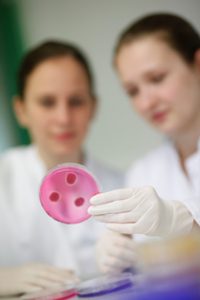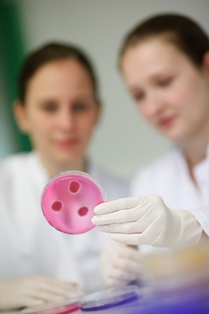
A new research project at the Hohenstein Group deals with antimicrobial effects of Lewis acids that are applied on textile surfaces.
Results of this work may significantly contribute to countermeasures against multi-resistant bacteria as found, for example, in medical facilities.
Many areas of everyday and professional life require antimicrobial protection. Such an effect on textile surfaces is currently achieved by the utilization of silver or ammonium containing compounds. However, the use of such compounds is questionable with respect to possible adverse ecological and toxicological effects. In addition, these compounds are generally expensive.
Lewis acids exhibit an acidic surface effect and an antimicrobial effect has been demonstrated. Therefore, these com,pounds can already be found in applications such as the cleaning of floors in hospitals. However, they have not been applied on textile surfaces. In presence of moisture, Lewis acids (metal oxides, e.g. zinc oxide) generate low pH-values on their surfaces resulting in antimicrobial effects comparable to the natural protective acid mantle of human skin.
Compared to commercially available antimicrobial substances, Lewis acids have proven to be useful against different pathogens like fungi, bacteria and even viruses. Furthermore, they have been found to be very effective and stable even during exposure to human sweat and proteins. Besides, estimations suggest that the use of Lewis acids in antimicrobial textile coatings may result in cost-reductions of up to 90%.
In the current project at the Hohenstein Group, researchers will cooperate closely with manufacturers of products for the textile industry such as knitted and woven fabrics, textile auxiliaries and textile finishers. Part of the work includes the determination of suitable metal oxides featuring very low solubility in water and to be applied on textile surfaces. By combination of different substances, synergistic effects might be generated. Systems based on a binder matrix and a Lewis acid will be selected, because this concept is already known from the functionalization of surfaces.
The project includes the development of an innovative finish based on suitable Lewis acids with different binder matrices. In order to provide relevant results for a broad audience, different textiles will be finished and characterized. Correlating the amount of Lewis acid applied to the surface of the textile and the amount finally released will serve as the basis for a cost/benefit analysis. Biocompatibility testing will be performed to ensure that any harmful effect on the skin originating from the treated textiles can be ruled out.
Based on the project results, optimized compositions for antimicrobial textile finishes and the corresponding process parameters will be provided to the textile industry.
The expected research results will meet practical requirements of the textile industry and, in consequence, can be applied directly to current product development.
